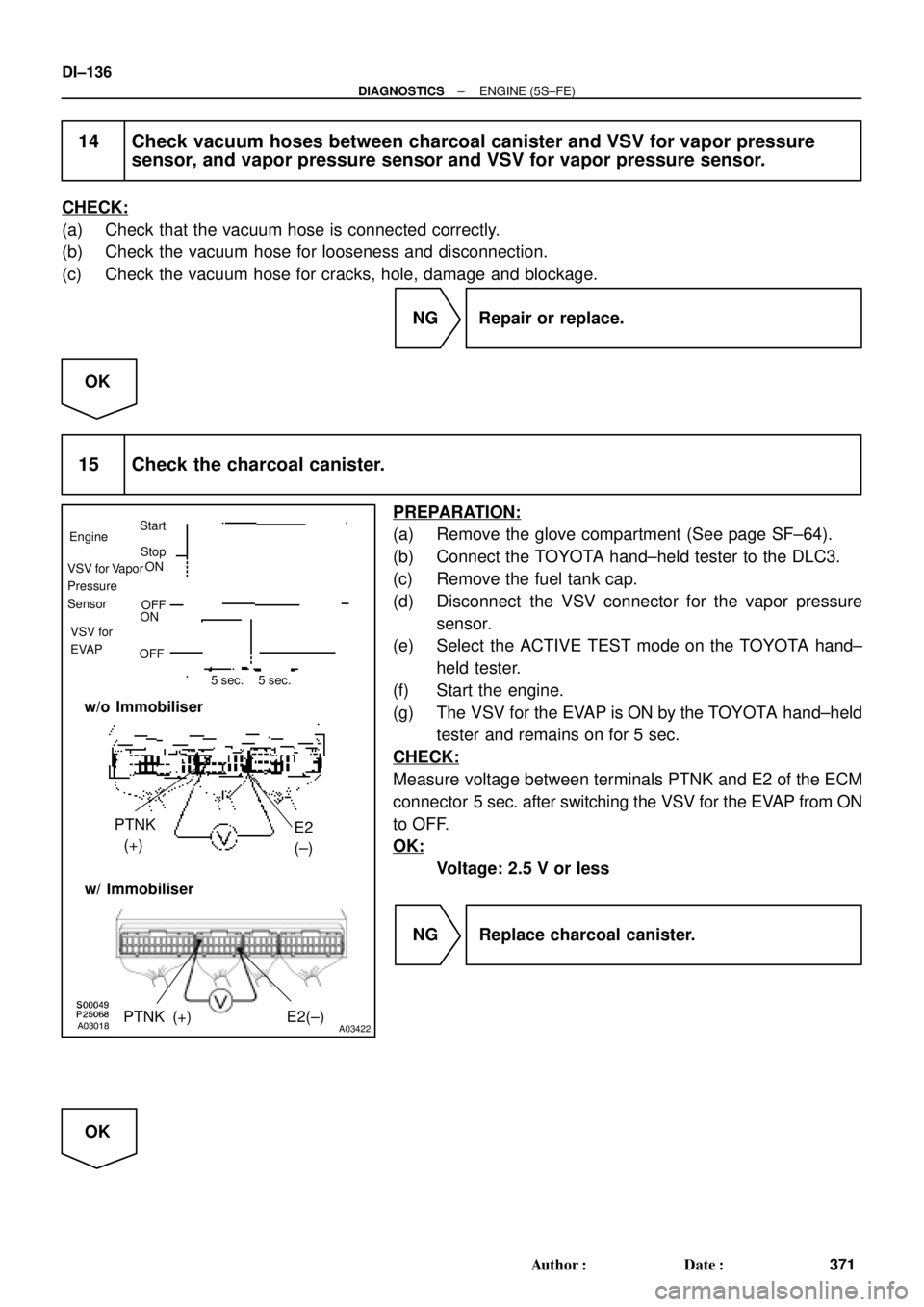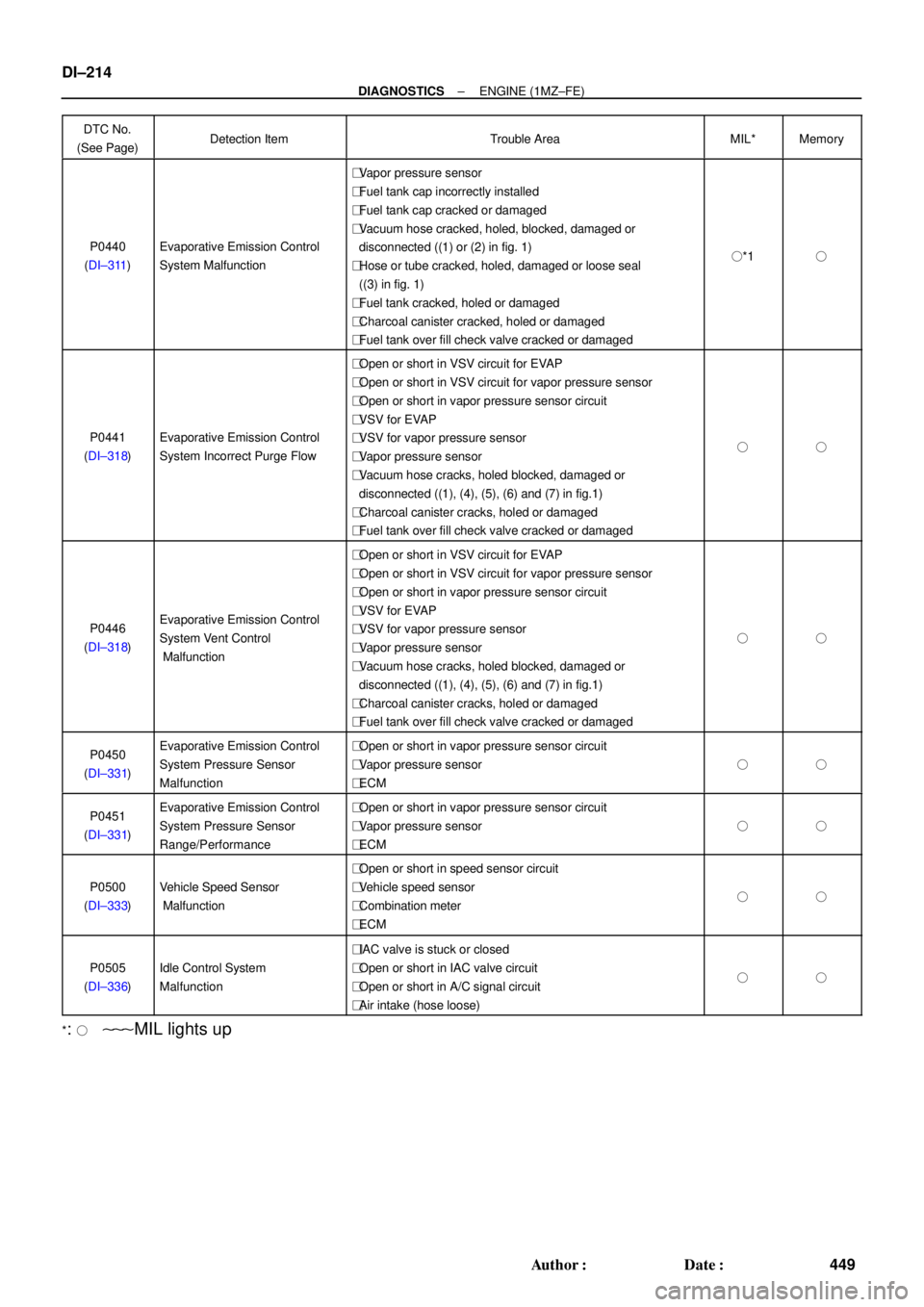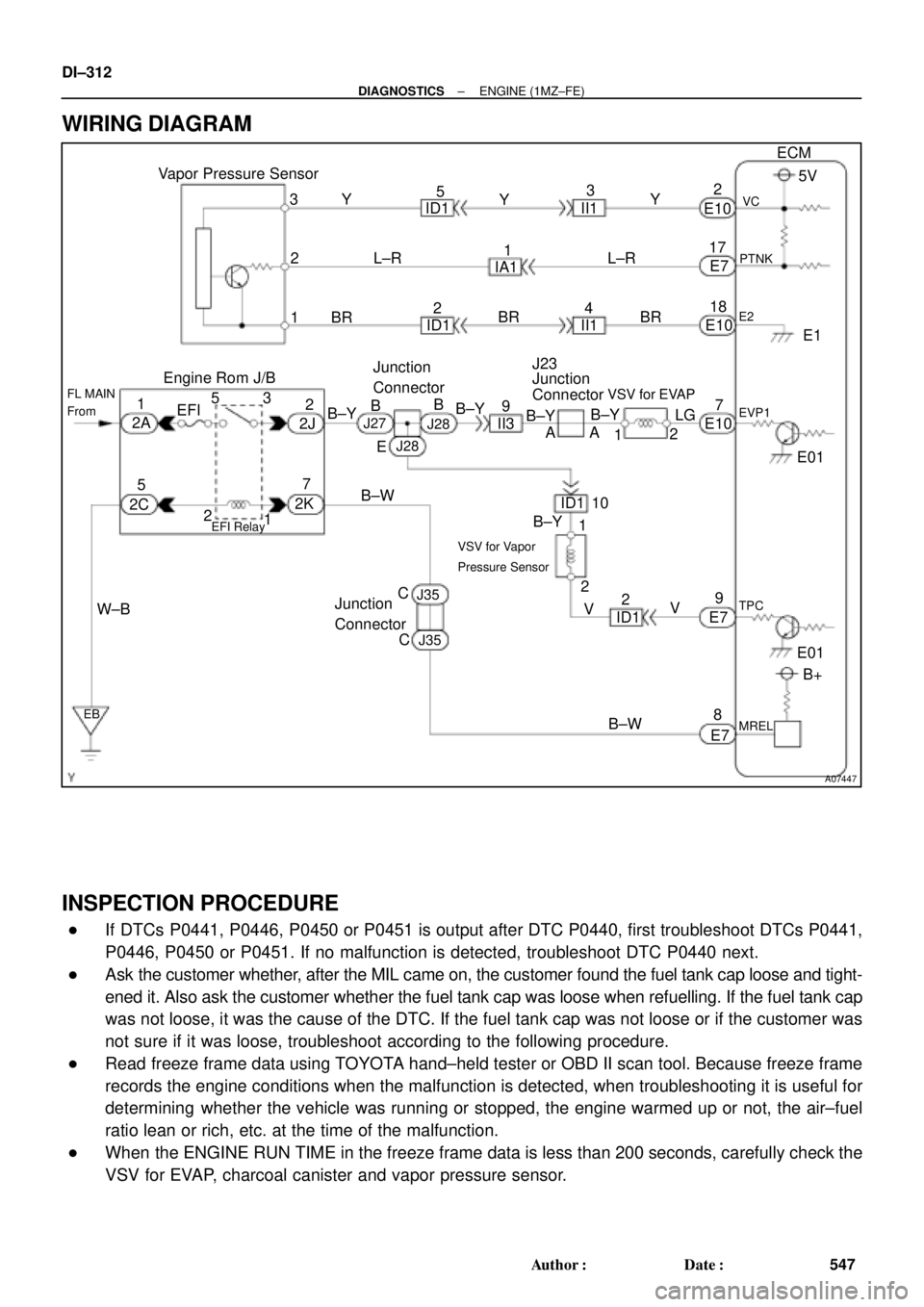Page 1336 of 4592
A01653
DI±124
± DIAGNOSTICSENGINE (5S±FE)
359 Author�: Date�:
1 Check whether hose close to fuel tank have been modified, and check whether
there are signs of any accident near the fuel tank or charcoal canister.
CHECK:
Check for cracks, deformation and loose connection of the fol-
lowing parts.
�Fuel tank
�Charcoal canister
�Fuel tank filler pipe
�Hoses and tubes around fuel tank and charcoal
canister
NG Repair or replace.
OK
2 Check that fuel tank cap is TOYOTA genuine parts.
NG Replace to TOYOTA genuine parts.
OK
3 Check that fuel tank cap is correctly installed.
NG Correctly install fuel tank cap.
OK
4 Check fuel tank cap (See page EC±6).
NG Replace fuel tank cap.
OK
Page 1337 of 4592
± DIAGNOSTICSENGINE (5S±FE)
DI±125
360 Author�: Date�:
5 Check filler neck for damage.
PREPARATION:
Remove the fuel tank cap.
CHECK:
Visually check the filler neck for damage.
NG Replace filler neck.
OK
6 Check vacuum hoses between vapor pressure sensor and VSV for vapor pres-
sure sensor, and VSV for vapor pressure sensor and charcoal canister.
CHECK:
(a) Check that the vacuum hose is connected correctly.
(b) Check the vacuum hose for looseness and disconnection.
(c) Check the vacuum hose for cracks, hole and damage.
NG Repair or replace.
OK
7 Check hose and tube between fuel tank and charcoal canister.
CHECK:
(a) Check for proper connection of the fuel tank and fuel evap pipe, fuel evap pipe and fuel tube under
the floor, fuel tube under the floor and charcoal canister.
(b) Check the hose and tube for cracks, hole and damage.
NG Repair or replace.
OK
Page 1340 of 4592
DI±128
± DIAGNOSTICSENGINE (5S±FE)
363 Author�: Date�:
12 Check fuel tank and fuel tank over fill check valve for cracks and damage
(See page EC±6).
NG Replace fuel tank or fuel tank over fill check
valve.
OK
It is likely that vehicle user did not properly close fuel tank cap. Please explain to customer how
to properly install fuel tank cap.
Page 1348 of 4592

A03018A03422
ON EngineStart
Stop
VSV for Vapor
Pressure
Sensor
OFFOFF
ON
VSV for
EVAP
5 sec. 5 sec.
PTNK
(+)E2
(±) w/o Immobiliser
w/ Immobiliser
PTNK (+) E2(±)
DI±136
± DIAGNOSTICSENGINE (5S±FE)
371 Author�: Date�:
14 Check vacuum hoses between charcoal canister and VSV for vapor pressure
sensor, and vapor pressure sensor and VSV for vapor pressure sensor.
CHECK:
(a) Check that the vacuum hose is connected correctly.
(b) Check the vacuum hose for looseness and disconnection.
(c) Check the vacuum hose for cracks, hole, damage and blockage.
NG Repair or replace.
OK
15 Check the charcoal canister.
PREPARATION:
(a) Remove the glove compartment (See page SF±64).
(b) Connect the TOYOTA hand±held tester to the DLC3.
(c) Remove the fuel tank cap.
(d) Disconnect the VSV connector for the vapor pressure
sensor.
(e) Select the ACTIVE TEST mode on the TOYOTA hand±
held tester.
(f) Start the engine.
(g) The VSV for the EVAP is ON by the TOYOTA hand±held
tester and remains on for 5 sec.
CHECK:
Measure voltage between terminals PTNK and E2 of the ECM
connector 5 sec. after switching the VSV for the EVAP from ON
to OFF.
OK:
Voltage: 2.5 V or less
NG Replace charcoal canister.
OK
Page 1426 of 4592

DI±214
± DIAGNOSTICSENGINE (1MZ±FE)
449 Author�: Date�:
DTC No.
(See Page)Detection ItemTrouble AreaMIL*Memory
P0440
(DI±311)Evaporative Emission Control
System Malfunction
�Vapor pressure sensor
�Fuel tank cap incorrectly installed
�Fuel tank cap cracked or damaged
�Vacuum hose cracked, holed, blocked, damaged or
disconnected ((1) or (2) in fig. 1)
�Hose or tube cracked, holed, damaged or loose seal
((3) in fig. 1)
�Fuel tank cracked, holed or damaged
�Charcoal canister cracked, holed or damaged
�Fuel tank over fill check valve cracked or damaged
�*1�
P0441
(DI±318)Evaporative Emission Control
System Incorrect Purge Flow
�Open or short in VSV circuit for EVAP
�Open or short in VSV circuit for vapor pressure sensor
�Open or short in vapor pressure sensor circuit
�VSV for EVAP
�VSV for vapor pressure sensor
�Vapor pressure sensor
�Vacuum hose cracks, holed blocked, damaged or
disconnected ((1), (4), (5), (6) and (7) in fig.1)
�Charcoal canister cracks, holed or damaged
�Fuel tank over fill check valve cracked or damaged
��
P0446
(DI±318)Evaporative Emission Control
System Vent Control
Malfunction
�Open or short in VSV circuit for EVAP
�Open or short in VSV circuit for vapor pressure sensor
�Open or short in vapor pressure sensor circuit
�VSV for EVAP
�VSV for vapor pressure sensor
�Vapor pressure sensor
�Vacuum hose cracks, holed blocked, damaged or
disconnected ((1), (4), (5), (6) and (7) in fig.1)
�Charcoal canister cracks, holed or damaged
�Fuel tank over fill check valve cracked or damaged
��
P0450
(DI±331)Evaporative Emission Control
System Pressure Sensor
Malfunction�Open or short in vapor pressure sensor circuit
�Vapor pressure sensor
�ECM
��
P0451
(DI±331)Evaporative Emission Control
System Pressure Sensor
Range/Performance�Open or short in vapor pressure sensor circuit
�Vapor pressure sensor
�ECM
��
P0500
(DI±333)Vehicle Speed Sensor
Malfunction
�Open or short in speed sensor circuit
�Vehicle speed sensor
�Combination meter
�ECM
��
P0505
(DI±336)Idle Control System
Malfunction
�IAC valve is stuck or closed
�Open or short in IAC valve circuit
�Open or short in A/C signal circuit
�Air intake (hose loose)
��
*: ����� MIL lights up
Page 1523 of 4592

A01652
ECM
Vapor Pressure
Sensor
VSV for Vapor
Pressure Sensor VSV
for EVAP
Charcoal Canister
Fuel Tank (1)
(2)
(3) fig. 1
(6)
(4)
(5) (7)
Fuel Tank Over Fill
Check Valve
(8)
(9)
± DIAGNOSTICSENGINE (1MZ±FE)
DI±311
546 Author�: Date�:
DTC P0440 Evaporative Emission Control System
Malfunction
CIRCUIT DESCRIPTION
The vapor pressure sensor and VSV for vapor pressure sensor are used to detect abnormalities in the evap-
orative emission control system.
The ECM decides whether there is an abnormality in the evaporative emission control system based on the
vapor pressure sensor signal.
DTC P0440 is recorded by the ECM when evaporative emissions leak from the components within the dotted
line in fig. 1 below, or when the vapor pressure sensor malfunctions.
DTC No.DTC Detecting ConditionTrouble Area
P0440Fuel tank pressure is atmospheric pressure after vehicle is
driven for 20 min. (2 trip detection logic)
�Vapor pressure sensor
�Fuel tank cap incorrectly installed
�Fuel tank cap cracked or damaged
�Vacuum hose cracked, holed, blocked, damaged or
disconnected ((1) or (2) in fig. 1)
�Hose or tube cracked, holed, damaged or loose seal
((3) in fig. 1)
�Fuel tank cracked, holed or damaged
�Charcoal canister cracked, holed or damaged
�Fuel tank over fill check valve cracked or damaged
DI4DT±01
Page 1524 of 4592

A07447
Vapor Pressure Sensor
2J2
9J23
B±Y
V
VSV for EVAP
LG
AA
2
1ECM
5V
VC
PTNK
E1
E2
EVP1
E01
E01
TPC
3
2
Engine Rom J/B
MREL VSV for Vapor
Pressure Sensor
II3
EB
B±W
W±BL±R Y
1BRE10
E7
E10
E72
17
18
7
9
E78
EFI Relay
IA1 L±RY Y
ID1 II13
5
1
II1 BR
BR
ID1 E10
B±Y
J28 J27
B
ID1 10
1
2
ID12 2A
7 1
2C5
2K 53
2
1 EFI
B±WFL MAIN
From
24
B+
J28E B±YB
B±Y
B±Y
V
J35
J35C
C Junction
Connector
Junction
ConnectorJunction
Connector DI±312
± DIAGNOSTICSENGINE (1MZ±FE)
547 Author�: Date�:
WIRING DIAGRAM
INSPECTION PROCEDURE
�If DTCs P0441, P0446, P0450 or P0451 is output after DTC P0440, first troubleshoot DTCs P0441,
P0446, P0450 or P0451. If no malfunction is detected, troubleshoot DTC P0440 next.
�Ask the customer whether, after the MIL came on, the customer found the fuel tank cap loose and tight-
ened it. Also ask the customer whether the fuel tank cap was loose when refuelling. If the fuel tank cap
was not loose, it was the cause of the DTC. If the fuel tank cap was not loose or if the customer was
not sure if it was loose, troubleshoot according to the following procedure.
�Read freeze frame data using TOYOTA hand±held tester or OBD II scan tool. Because freeze frame
records the engine conditions when the malfunction is detected, when troubleshooting it is useful for
determining whether the vehicle was running or stopped, the engine warmed up or not, the air±fuel
ratio lean or rich, etc. at the time of the malfunction.
�When the ENGINE RUN TIME in the freeze frame data is less than 200 seconds, carefully check the
VSV for EVAP, charcoal canister and vapor pressure sensor.
Page 1525 of 4592
A01653
± DIAGNOSTICSENGINE (1MZ±FE)
DI±313
548 Author�: Date�:
1 Check whether hose close to fuel tank have been modified, and check whether
there are signs of any accident near fuel tank or charcoal canister.
CHECK:
Check for cracks, deformation and loose connection of these
parts:
�Fuel tank
�Charcoal canister
�Fuel tank filler pipe
�Hoses and tubes around fuel tank and charcoal
canister
NG Repair or replace.
OK
2 Check that fuel tank cap is TOYOTA genuine parts.
NG Replace to TOYOTA genuine parts.
OK
3 Check that fuel tank cap is correctly installed.
NG Correctly install fuel tank cap.
OK
4 Check fuel tank cap (See page EC±6).
NG Replace fuel tank cap.
OK